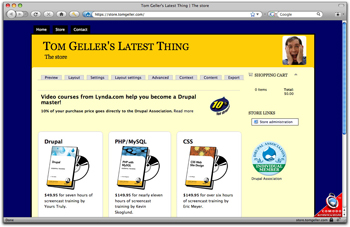Yesterday, Indian firm Gloscon announced its intent to offer Drupal certification. It joins Acquia, which first discussed its forthcoming “Yellow Jersey” program last March. To the best of my knowledge, only U.K.-based NobleProg currently “certifies” Drupal developers, although other training companies (Lullabot large among them) provide course-completion certificates; as far as I can tell, these other course certificates hold at least as much weight as NobleProg’s documents.
Which brings us to the point: Certification has only the value the market gives it. “Market” here refers not to the certified, but to their prospective employers and clients. That the market recognizes one certification over another isn’t necessarily a reflection of quality: an MBA from Harvard will open more doors than one from Florida Tech, even if the latter has better teachers. So it goes.
Recognition comes from two sources: word of mouth and active promotion. I’d say that Lullabot is the leader in the former, but believe that Acquia, with its US$7,000,000 in initial funding, has tremendous potential to blow away all competition in the latter.
I don’t know much about Gloscon or NobleProg, except that I hadn’t heard of them until yesterday. That’s my own ignorance… but it’s also a data point. Both are outside the U.S., which gives them an extra barrier for gaining recognition. (My country has many faults, it does host the world’s leading advertising and promotion machinery.)
One oft-raised issue with all these certifications is that they’re led by commercial firms — which some stakeholders fear will cause conflicts of interest. The obvious solution would be for a neutral, third-party nonprofit company to manage certification. Advantages:
- Undivided focus. Such an organization could concentrate solely on certification and associated tasks (such as market promotion).
- Ability to form “clean” partnerships (with, for example, Drupal Association)
- Flexible structure. For example, it could certify the courses of Lullabot, NobleProg, etc. as being part of a bigger certification.
- Market perception of neutrality.
- Additional venues for distributed fundraising through corporate sponsorships, grants, etc.
The big disadvantage? It’s still not evident that the market need for Drupal certification is big enough to support such an organization. Plus it has no obvious source of seed money, which I believe should be at least $200,000 for the first year to make a serious impact. (Remember, advertising and public relations are a major part of what would give such a program value. Those things cost money.)
On the other hand, it could quickly become self-supporting — if the market is big enough. And just as a side effect, the boost it would give to Drupal’s visibility in the business community would be incomparable.
Now, I founded and ran a high-tech nonprofit organization for about a year and a half — here’s its old Web site at its peak on archive.org, if you’re curious. It was founded without money, gained (comparatively) huge public recognition, got its 501(c)(3) recognition from the U.S. government, and fell apart immediately after I handed off the reins. It was, frankly, a deeply traumatic experience.
But among the many things it taught me, one lesson stands out: Don’t go it alone. Delegate; work with partners; follow the market. The emerging leader in Drupal certification will need to know this, regardless of whether it’s a nonprofit or commercial organization.
There’s a saying that goes something like: “Smart leaders don’t try to get a crowd to follow them. They find a crowd and run to its front.” The question: Is the need for Drupal certification a big enough “crowd” to coalesce a leader?
 I’m pleased to announce the opening of store.tomgeller.com, which donates 10% of the purchase price on all Drupal-related products to Drupal Association.
I’m pleased to announce the opening of store.tomgeller.com, which donates 10% of the purchase price on all Drupal-related products to Drupal Association. I love old paper. When I hold an old newspaper, I feel the vibrations of its life over the past century. The texture of its surface reflects truly the moisture of the air that surrounded it, the dust that settled on it, the fingers that gripped its edges. When you can read these things in an object, you’re plunged into a world of senses.
I love old paper. When I hold an old newspaper, I feel the vibrations of its life over the past century. The texture of its surface reflects truly the moisture of the air that surrounded it, the dust that settled on it, the fingers that gripped its edges. When you can read these things in an object, you’re plunged into a world of senses.